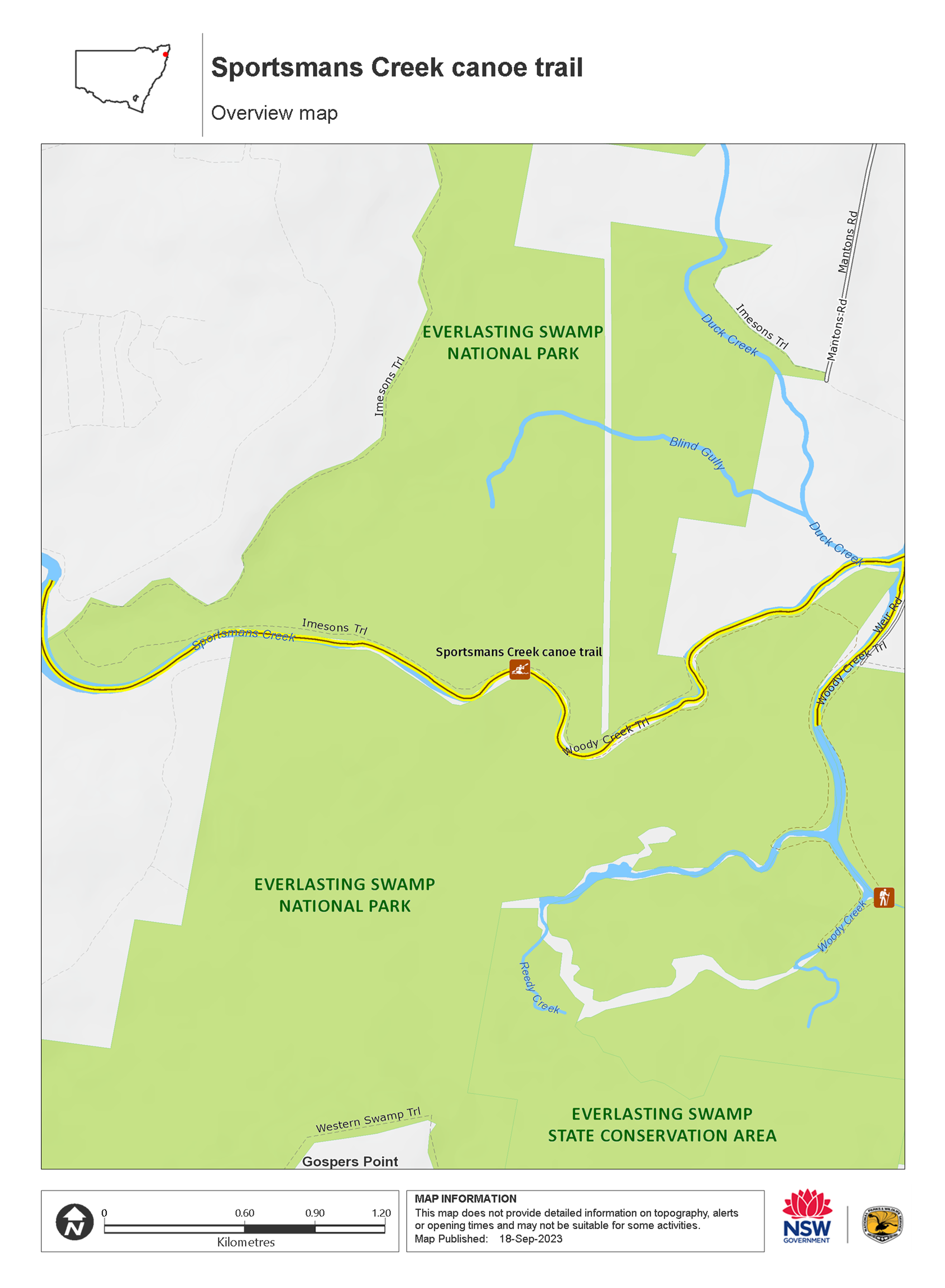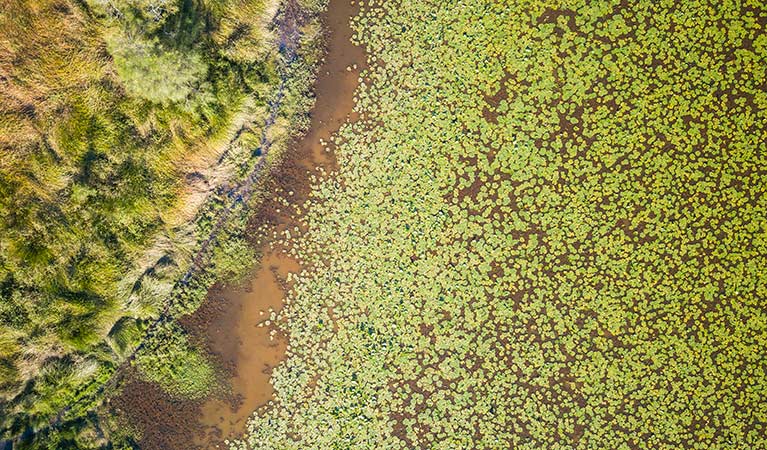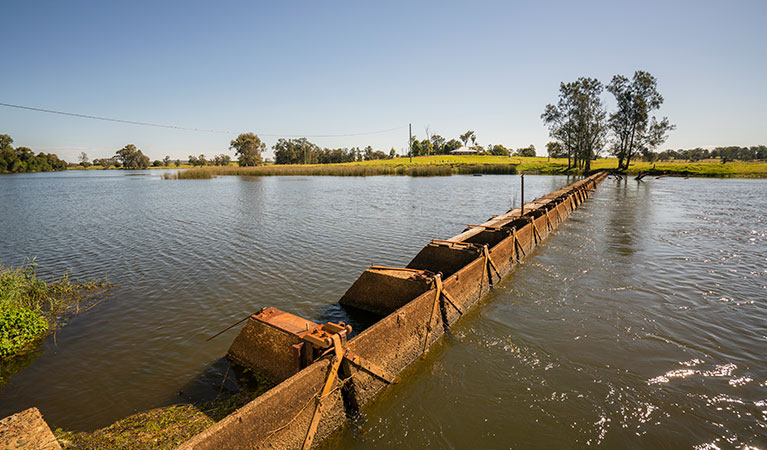Sportsmans Creek canoe trail
Everlasting Swamp National Park
Overview
Canoe, kayak and fish the tranquil waters of Sportsmans Creek in Everlasting Swamp National Park. Perfect for families, this easy flat-water paddle takes you back to nature in a birdwatcher’s paradise beside the Clarence River.
- Accessibility
- Hard
- Distance
- 11km return
- Time suggested
- 4hrs 30min
- Grade
- Easy
- What to
bring - Drinking water, hat, sunscreen, raincoat, snacks, sturdy shoes, suitable clothing, first aid kit
- Please note
- You can enter and exit the canoe route wherever creekbanks are low enough, but the only vehicle access is at Woody Creek launch point.
- It's a good idea to take a picnic lunch.
- Sportsmans Creek and Woody Creek water levels are always high enough to paddle.
- Remember your fishing rod to cast a line for bass and mullet.
- From the south end of Woody Creek you can also paddle west into Reedy Creek, then to Teal Lagoon in the heart of the wetland. To reach Teal Lagoon, you’ll need to carry your canoe around fallen trees lying across Reedy creek.
Explore a rare coastal wetland with an easy paddle along the tree-lined creeks of Everlasting Swamp National Park. Canoeing gives you a rare opportunity to quietly see jabiru and brolgas in their natural habitat.
Launching at Woody Creek you’ll paddle to the right, gliding past green rushes and violet water lilies as ducks take flight. Leave the outside world behind as the sounds of frogs and calls of birds take over.
Where Woody Creek meets Sportsmans Creek, paddle left along Sportsmans Creek. Continue for 5.1km shaded by old red gum, swamp oak and paperbark trees before turning around to return to Woody Creek. Keep your binoculars handy and go quietly for your best chance to see plentiful wildlife drawn to this wetland, known to birdwatchers as the ‘Kakadu of the south’.
Map

Map legend

Local alerts
For the latest updates on fires, closures and other alerts in this area, see https://uat.nswparks.cloud/things-to-do/canoeing-paddling-experiences/sportsmans-creek-canoe-trail/local-alerts
Park info
- in Everlasting Swamp National Park in the North Coast region
Everlasting Swamp National Park is open all year, but may have to close at times due to weather conditions or fire danger.
Visitor info
All the practical information you need to know about Sportsmans Creek canoe trail.
Maps and downloads
Learn more
Sportsmans Creek canoe trail is in Everlasting Swamp National Park. Here are just some of the reasons why this park is special:
All about the birds

Birds are the real drawcard at Everlasting Swamp. After flooding rainfall this wetland really goes into overdrive. Wading birds are drawn to the park and large flocks of migratory birds pass through. Watch pelicans land like sea planes or look up in trees for huge stick nests of endangered black-necked storks—Australia’s only stork. Come to spot other birds including teals, swamp harriers, black swans and white-bellied sea eagles. With some of the largest flocks of vulnerable brolga in NSW, you may see up to 70 of these majestic cranes bob, bow and strut in courtship.
- Woody Creek walking track Take a tranquil walk into the heart of Everlasting Swamp on this easy, family-friendly walking track near Grafton. This shimmering wetland in the Clarence Valley is a top spot for birdwatching.
Wild wetland refuge

Bursting with life, Everlasting Swamp National Park is named for the large number of waterfowl living in the backswamp next to Clarence River. Sportsmans Creek meanders through the wetland’s heart, then into Clarence River. Its banks are shaded by swamp oak, gum and paperbark trees. Beyond these raised creekbanks you’ll see lower-lying sedgeland of grasses, rushes and endangered reeds—a haven for wading birds. When summer rains flood the area, the creekbanks work like sides of a giant bathtub, holding water in the wetland then slowly letting it drain.
- Woody Creek walking track Take a tranquil walk into the heart of Everlasting Swamp on this easy, family-friendly walking track near Grafton. This shimmering wetland in the Clarence Valley is a top spot for birdwatching.
A history of hunting and farming

Vast, forested and always wet, Everlasting Swamp was so-named in the 1800s by European Australians who came for easy game. In Sportsmans Creek they caught huge fish and shot birds in disturbingly large numbers. From 1910, landholders worked to tame the wetland’s extremes. They cleared forest, built weirs to prevent natural inflows of salty water at high tide and built drains to turn the swamp into pasture land. Part of Everlasting Swamp’s heritage, you can still see some of these structures today.
Plants and animals protected in this park
Animals
-

Eastern snake-necked turtle (Chelodina longicollis)
Found across most of NSW, the eastern snake-necked turtle, also known as the eastern long-necked turtle, can be found in swamps, lakes and inland waterways. This freshwater turtle is carnivorous and lives most of its life submerged on the water’s edge, searching for worms and snails.
-

Eastern water dragon (Intellagama lesueurii lesueurii)
The eastern water dragon is a subaquatic lizard found in healthy waterways along eastern NSW, from Nowra to halfway up the Cape York Pensinsula. It’s believed to be one of the oldest of Australian reptiles, remaining virtually unchanged for over 20 million years.
-

Brown-striped frog (Lymnastes peronii)
One of the most common frogs found in Australia, the ground-dwelling brown-striped frog lives in ponds, dams and swamps along the east coast. Also known as the striped marsh frog, this amphibian grows to 6.5cm across and has a distinctive ‘tok’ call that can be heard all year round.
-

Swamp wallaby (Wallabia bicolor)
The swamp wallaby, also known as the black wallaby or black pademelon, lives in the dense understorey of rainforests, woodlands and dry sclerophyll forest along eastern Australia. This unique Australian macropod has a dark black-grey coat with a distinctive light-coloured cheek stripe.
-

Tawny frogmouth (Podargus strigoides)
Found throughout Australia, the tawny frogmouth is often mistaken for an owl due to its wide, powerful beak, large head and nocturnal hunting habits. The ‘oom oom oom’ call of this native bird can be heard echoing throughout a range of habitats including heath, woodlands and urban areas.
-

Wedge-tailed eagle (Aquila audax)
With a wingspan of up to 2.5m, the wedge-tailed eagle is Australia’s largest bird of prey. These Australian animals are found in woodlands across NSW, and have the ability to soar to heights of over 2km. If you’re bird watching, look out for the distinctive diamond-shaped tail of the eagle.
-

White-bellied sea eagle (Haliaeetus leucogaster)
White-bellied sea eagles can be easily identified by their white tail and dark grey wings. These raptors are often spotted cruising the coastal breezes throughout Australia, and make for some scenic bird watching. Powerful Australian birds of prey, they are known to mate for life, and return each year to the same nest to breed.
Plants
-

Grey mangrove (Avicennia marina)
Grey mangrove is the most common and widespread mangrove found within intertidal zones across Australia, and throughout the world. Growing to a height of 3-10m, they thrive best in estuaries with a mix of fresh and salt water. They excrete excess salt through their long thick leaves, and absorb oxygen through their aerial root system.

